HOME>Company Overview
- Company NameKosugi Foods Co., Ltd.
- FoundedSeptember 1933
- IncorporatedAugust 1962
- Head Office401 Hanakaito, Nonbe, Kuwana City, Mie 511-0931, Japan
View map here - Factory401 Hanakaito, Nonbe, Kuwana City , Mie 511-0931, Japan
View map here - BusinessManufacture and sale of natto (fermented soybeans)
- Capital10 million yen
- Annual Sales1,634 million yen(June 2024)1,502 million yen(June 2023)1,464 million yen(June 2022)
- Board of DirectorsPresident and Representative Director :Satoshi KosugiDirector :Tatsuhiro KosugiDirector :Akimasa Kosugi
- BanksThe Hyakugo Bank, Ltd., Yada Branch
San ju San Bank, Ltd., Masuo Branch
The Ogaki Kyoritsu Bank, Ltd., Kuwana Branch
Kuwanamie Shinkin Bank - AffiliationJapan Natto Cooperative Society Federation (JNCSF) (Tokai Natto Cooperative Association, regional chapter)
-
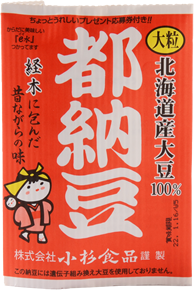 History of Packaging
History of Packaging 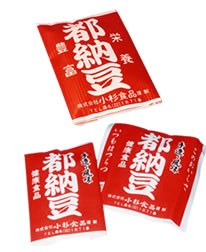 Miyako Natto’s packaging has evolved over time.
Miyako Natto’s packaging has evolved over time.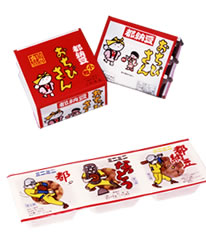 A nostalgic package design that evokes the Showa era.
A nostalgic package design that evokes the Showa era.
History
- September 1933Began producing natto (itohiki, the traditional “stringy” style) as Kosugi Shoten.
- August 1962Established Kosugi Foods Co., Ltd.Capital: 1 million yenCapital increased to 3 million yen.
- August 1972Constructed a new factory and relocated.
- July 1976Capital increased to 6 million yen.
- July 1979Opened the Yokkaichi Sales Office in the Hokusei Food Wholesale Complex.
- July 1991Capital increased to 10 million yen.
- November 1991Completed the new head office building.
- November 2000Completed the new Nonbe factory and relocated the head office.
- March 2001Certified by the Japan Grain Inspection Association as an organic JAS factory.
- September 2002satoshi Kosugi assumed the position of President and Representative Director.
- June 2003Began production and sales of organic natto made from domestically grown soybeans in Kanazawa.
- September 2003Launched “Tsuyudaku Natto.”
- May 2004Received the Director-General’s Award from the Tokai Regional Agricultural Administration Office for Nihon no otsubu (large-bean natto) at the 9th National Natto Appraisal Contest.
- April 2005Signed a technical partnership agreement with Ottogi Corporation (South Korea; now Otoki Corporation).
- March 2007Obtained Mie Prefecture HACCP certification.
- May 2009Received the Chairman’s Award from Noshinkai (an affiliate of JNCSF) for Nihon no kuromame (black soybean natto) at the 14th National Natto Appraisal Contest.
- March 2010Introduced the DC-15 functional natto strain (starter culture).
- February 2013Received the JNCSF Chairman’s Award (Merit Award) for kokusan kotsubu natto (domestically produced small-bean natto) at the 18th National Natto Appraisal Competition.
- June 2015Obtained Halal certification.
- February 2017Received the Minister of Agriculture, Forestry and Fisheries Award (Grand Prize) for Nihon no kuromame (black soybean natto) at the 22nd National Natto Appraisal Contest.
- February 2019Received the U.S. Soy Sustainability Ambassador Award for tsuyudaku natto (natto with extra sauce) at the 24th National Natto Appraisal Contest.
- January 2021Obtained JFS-B Standard certification.
- February 2021Began generating solar power using solar panels.
- August 2021Began using biomass-based ink for cups and packaging film.
- June 2023Reduced plastic use in natto containers by 5% (compared with our previous products).
- July 2023Obtained Vegan JAS certification.
- November 2023Received the U.S. Soy Sustainability Ambassador Award and the SSGA U.S. Award for “Tsuyudaku Natto” at the 27th National Natto Appraisal Contest.
- April 2024Registered as a Mie Prefecture SDGs Promotion Partner.
-
History of Ochibi-san
-
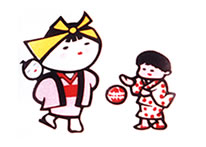 Kosugi Foods’ mascots—“Ochibi-san” and “the older sister giving Ochibi-san a piggyback ride”—once had a third companion: a child playing with a temari (a traditional Japanese handball).
Kosugi Foods’ mascots—“Ochibi-san” and “the older sister giving Ochibi-san a piggyback ride”—once had a third companion: a child playing with a temari (a traditional Japanese handball). -
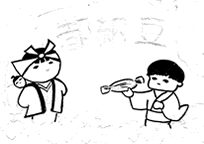 Here is the original illustration. At the time, no one could have imagined that these characters would become such beloved icons of our brand.
Here is the original illustration. At the time, no one could have imagined that these characters would become such beloved icons of our brand.




